Two of the most difficult skills in volleyball to evaluate statistically are blocking and digging. We’ll discuss defensive evaluation in another article; today we’ll focus on blocking.
Some of the challenges that make it difficult to stat blocking are the same that make it difficult to coach blocking:
The blocker doesn’t have full control. On most sets, the hitter can beat the blocker with the right shot. It’s possible to make a good block and still have the hitter kill the ball.
Many attacks never touch the block. At some levels, over half of attacks will touch the block, but at lower levels (such as high school), more than 3/4 of the attacks will go clean past the block. It’s difficult to evaluate the effectiveness of a block when the blocker doesn’t touch the ball.
There are lots of non-terminal blocks. At the NCAA women’s collegiate level, only about half of block touches are stuffs or tools/errors. It’s not always clear whether a “block touch” (that doesn’t result in a point for one team or the other) is a positive or negative play.
It can be difficult to separate the performance of the player from the system they play in.
The standard box score in the USA, the NCAA box score, is mediocre at best at giving you blocking information.
There’s a lot to unpack here, and we’ll need more than one article to really discuss blocking. Let’s start with the last point first.
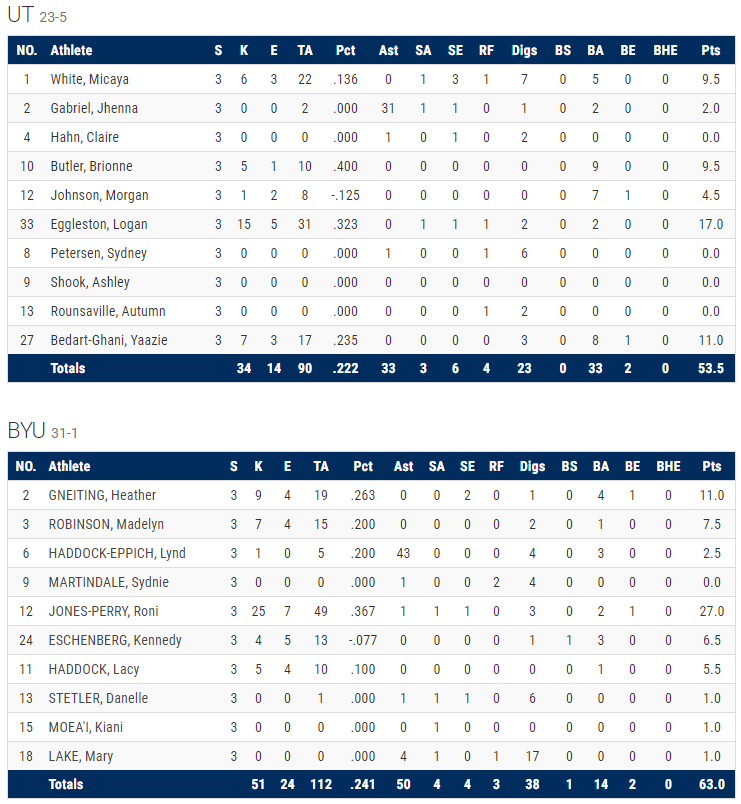
NCAA tournament box score: BYU vs Texas
We’ll take a look at this NCAA tournament match between BYU and Texas. The blocking information here is contained in the columns BS (“block solo”) and BA (“block assist”). The first thing you realize is that these distinctions are almost meaningless in modern NCAA volleyball, where almost every team is in some sort of help-block system. Between the two teams, there were 24 stuff blocks, and only one was scored as a solo.
By the NCAA blocking criteria:
A block assist (BA) is awarded when two or three players block the ball into the opponent’s court leading directly to a point. Each player blocking receives a block assist, even if only one player actually makes contact with the ball.
That means that on these plays, both blockers received equal credit:
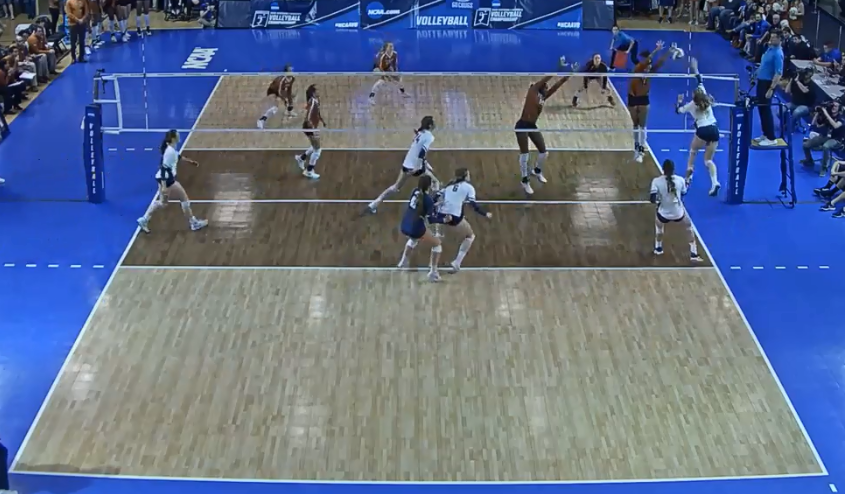
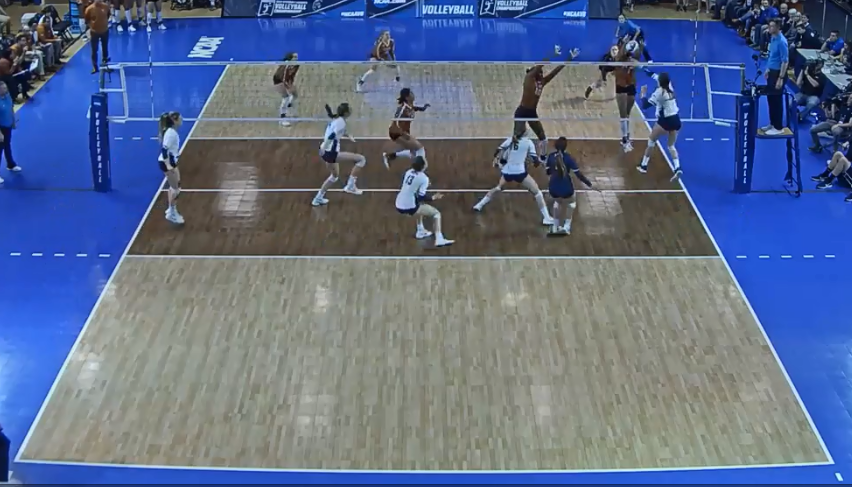

This isn’t to diminish the efforts of the Texas or BYU middle blockers. Their job is to try to get involved in the play as best they can. Middle blockers can and do block balls when they are this late by hitters who hit the ball low into the sharp angle. But on these particular plays, it’s difficult to say that both players should be credited with an equal impact on the play.
It also happens (although not in this match) that middle blockers will stuff a quick attack and one of the wing blockers will take part in the block enough to get credit for a block assist, although they were barely off the ground at hitter contact.
International blocking statistics do a bit better, as they only credit one player with the block.
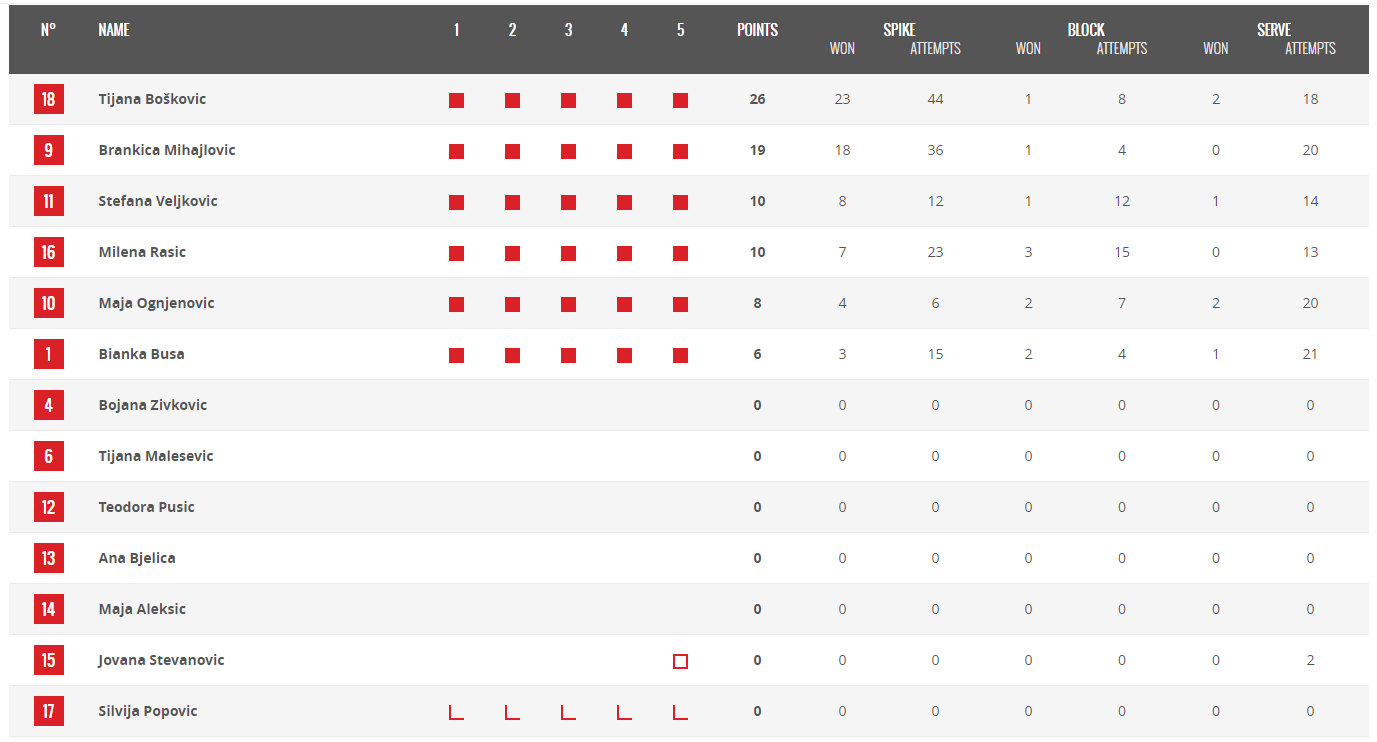
Serbia box score, 2018 FIVB World Championships Gold Medal Match vs Italy
The FIVB statistics also add an “attempts” category, which is every touch the blocker made in that match.
That gives us a little bit more information (2 out of 4 of Busa’s touches were stuffs, compared to 2 out of 7 for Ognjenovic, that seems to give her an advantage), but both box scores neglect very important information:
Both NCAA and FIVB box scores only provide information about the most positive blocking touch (stuff block) and neglect to include the most negative blocking touch- a tool or blocking error. This would be like recording only kills and aces and not hitting or serving errors. (Whoops, the FIVB box score does that as well? Well… at least it’s consistent!)
Just as hitting efficiency has a higher correlation to winning than just kill %, blocking efficiency has a higher correlation to winning than just recording stuff blocks.
The stat I really like for Blocking Efficiency is “Stuff to Tool Ratio.”
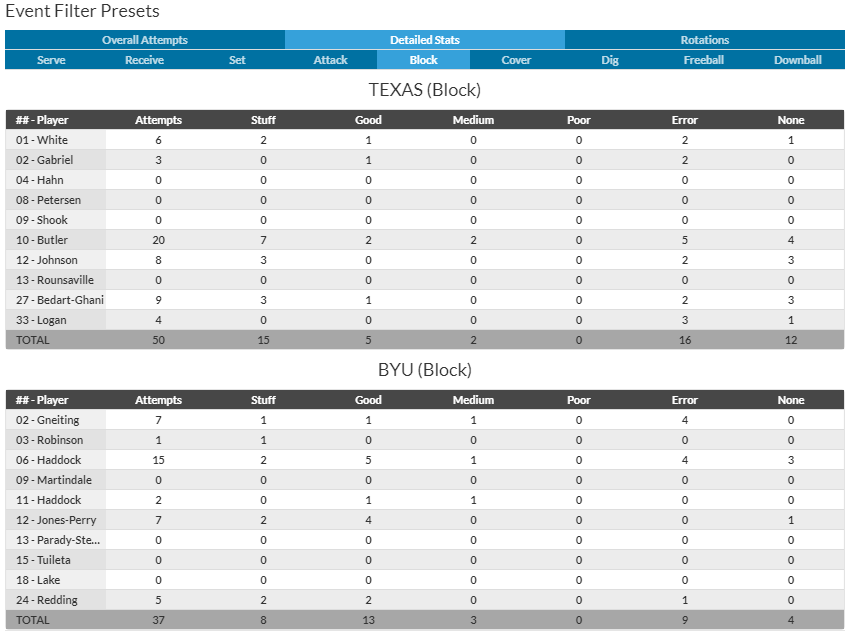
BYU vs Texas Blocking Statistics, courtesy of Volleymetrics.
Although the traditional box scores might be lacking, using more advanced statistical programs like DataVolley or Volleymetrics can give us more insight into what happened on the blocking end.
Quite a few individuals see their blocking statistics change. For Texas, Butler was credited with 4.5 blocks (9 BAs, each worth 0.5 blocks) by the NCAA but 7 by Volleymetrics. On the flip side, Johnson dropped from 3.5 (7 BAs) to 3 and Gabriel and Eggleston dropped from 2 BAs each to 0. BYU also sees some similar changes based on who actually made the block on each play.
Where it really gets interesting is when blocking errors are factored in.
At first glance, one of the stories of this match was the blocking advantage Texas had. They outblocked BYU 15 to 8! (NCAA box score actually had Texas with 16 blocks, but it’s likely they counted a ball BYU attacked into the net as a block- that happens sometimes.)
However, look at the blocking error column. This includes the blocker being in the net, as well as the hitter tooling the block. Texas had 16 and BYU had 9. Now things don’t look so lopsided. In terms of a raw +/-, both teams gave up 1 more point via blocking error than they scored via stuff block.
We could also measure this in a ratio or efficiency rating, by dividing stuffs by tools. In this case, Texas was 15/16 = 0.94 and BYU was 8/9 = 0.89. I call this ratio blocking efficiency, stuff-to-tool ratio, or just, “Stuff to Tool.” This is a stat that few people use that automatically upgrades your understanding of blocking effectiveness, both on the individual and team level.
It’s reasonable to assume that stuff blocking correlates well with blocking efficiency, just as kill % correlates well with hitting efficiency. But just as some hitters are high kill and high error, some blockers are both high stuff and high tool. This statistic also helps us coach. Teach players that their number-one job as a blocker is to stuff the ball. But the next most important thing is to not give up an easy point by getting tooled! Understanding both sides of this equation makes blockers better.
This brings us back to another reason NOT to use block solos and block assists. Using the NCAA logic for assigning block assists to any blocker involved in the block, whether they touched the ball or not, we’d have to assign block errors to any block involved in the block, whether they touched the ball or not. This strikes most people as absurd, so why are we assigning block assists to both players when only one made the block?
To summarize:
Block assists are almost meaningless. The FIVB method of assigning the block only to the player who blocked the ball gives more accurate information.
Both NCAA and FIVB statistics neglect at least half the story by only listing stuffs and not blocking errors.
Blocking efficiency (stuff-to-tool ratio) gives us a much clearer picture of a team or individual’s blocking effectiveness than just stuff blocks.
In Part 2, we’ll look at how the GMS Stats App analyzes blocking, why it’s different than Volleymetrics, and what to do about all those pesky non-terminal block touches!